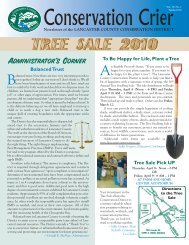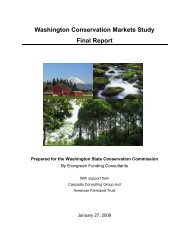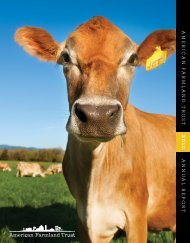Farms for the Future: Massachusetts - American Farmland Trust
Farms for the Future: Massachusetts - American Farmland Trust
Farms for the Future: Massachusetts - American Farmland Trust
You also want an ePaper? Increase the reach of your titles
YUMPU automatically turns print PDFs into web optimized ePapers that Google loves.
CHAPTER FIVERecommendationsAgricultural Preservation Restriction ProgramTo protect 20 percent of <strong>the</strong> Commonwealth’s land in farms by 2020 will require anincreased investment of $25–$30 million annually. A yearly investment of $15 millionis needed simply to keep pace with historic protection rates.Less than 12 percent of <strong>Massachusetts</strong>’ land in farms is permanently protected, yet <strong>the</strong> amountof land enrolled annually through <strong>the</strong> APR program has been declining as <strong>the</strong> cost of protectingit has been rising. While land values may be leveling off, an increase in current spending, to$15 million annually, will be required just to keep pace with <strong>the</strong> program’s historic average of2,300 acres protected per year. With a population of aging farmers and non-farming landownersretiring and relocating, farmland in <strong>Massachusetts</strong> is especially vulnerable to development as itpasses from one generation to <strong>the</strong> next. An aggressive goal of permanently protecting a total of20 percent of <strong>the</strong> Commonwealth’s farmland by 2020 would provide new opportunities <strong>for</strong>young and beginning farmers, spur additional investments in farm businesses, and help stabilize aland base that is growing in importance <strong>for</strong> local food and renewable energy production, waterfiltration and carbon sequestration.Reinvest all funds received from <strong>the</strong> federal Farm and Ranch Lands Protectionprogram in <strong>the</strong> APR program.From 2003 through 2007, <strong>the</strong> U.S. Department of Agriculture allocated over $19 million to<strong>Massachusetts</strong> through <strong>the</strong> federal Farm and Ranch Lands Protection Program (FRPP). Yet<strong>Massachusetts</strong> has used less than $9 million of that funding <strong>for</strong> <strong>the</strong> APR program. While <strong>the</strong>Department of Agricultural Resources (MDAR) is under no obligation to use <strong>the</strong> FRPP reimbursement<strong>for</strong> <strong>the</strong> program, <strong>the</strong> use of this funding <strong>for</strong> o<strong>the</strong>r programs within <strong>the</strong> department,primarily <strong>the</strong> Farm Viability Enhancement Program (FVEP), has limited <strong>the</strong> impact of <strong>the</strong> federalprogram’s focus on permanent farmland protection ef<strong>for</strong>ts. The Patrick administration has madean important change in this regard, dedicating $2.6 million of <strong>the</strong> $3.6 million of <strong>the</strong> 2007 reimbursementto <strong>the</strong> APR program. An investment of <strong>the</strong> entire FRPP reimbursement—$5.7 millionin 2008 and potentially higher in future years as FRPP spending increases under <strong>the</strong> 2008Farm Bill—in addition to <strong>the</strong> yearly $13.35 million state investment as envisioned in <strong>the</strong> 2008Environmental Bond would provide <strong>the</strong> APR Program with $19 million. This would allow <strong>the</strong>program to improve its monitoring and en<strong>for</strong>cement of existing restrictions while aggressivelypursuing new acquisitions.Establish a process to consider changes in APR program policies.New regulations <strong>for</strong> <strong>the</strong> APR program are expected in 2009. While <strong>the</strong>se regulations willprovide needed guidance on program implementation, <strong>the</strong>y are not likely to address a number ofimportant program policies that impact <strong>the</strong> type and quality of applications to <strong>the</strong> program, <strong>the</strong>selection and approval process, and <strong>the</strong> continued viability of farms with land enrolled in <strong>the</strong>program. These policies include <strong>the</strong> program’s current cap on prices paid per acre, its eligibilitycriteria and ranking system, <strong>the</strong> local contribution requirement, and its policy with regard tohousing on protected parcels. The MDAR should establish a <strong>for</strong>mal process that invites stakeholderparticipation in <strong>the</strong> review of and recommendation <strong>for</strong> changes to <strong>the</strong>se and o<strong>the</strong>rprogram policies.16<strong>American</strong> <strong>Farmland</strong> <strong>Trust</strong>



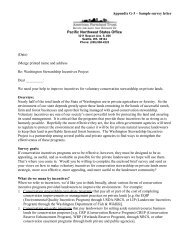

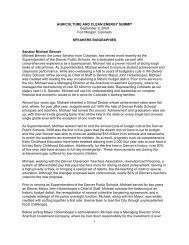
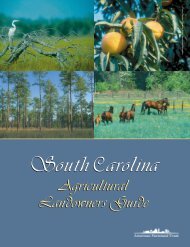
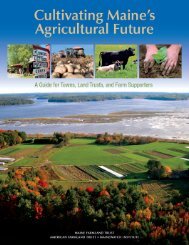
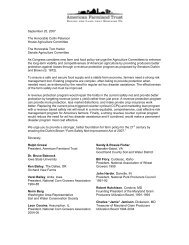
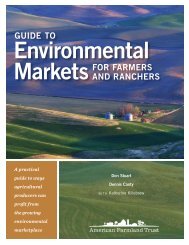
![Farmland by the Numbers [PDF] - American Farmland Trust](https://img.yumpu.com/31549391/1/190x245/farmland-by-the-numbers-pdf-american-farmland-trust.jpg?quality=85)


